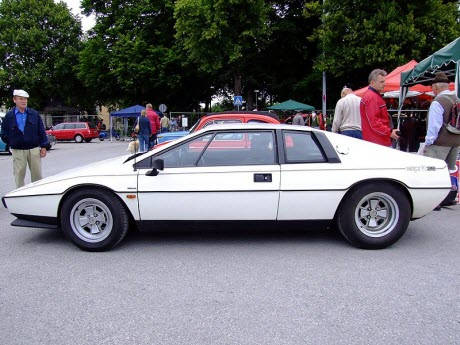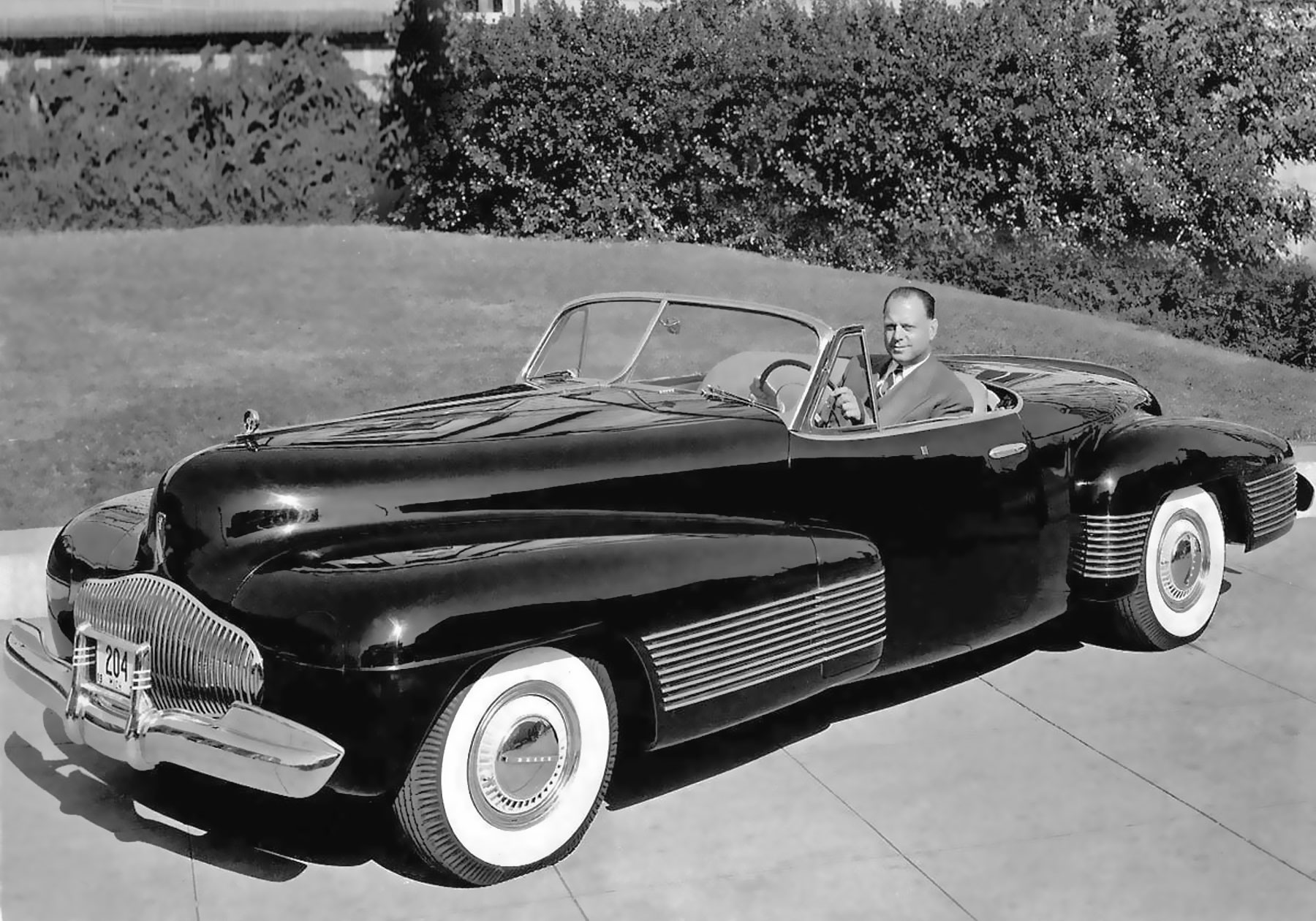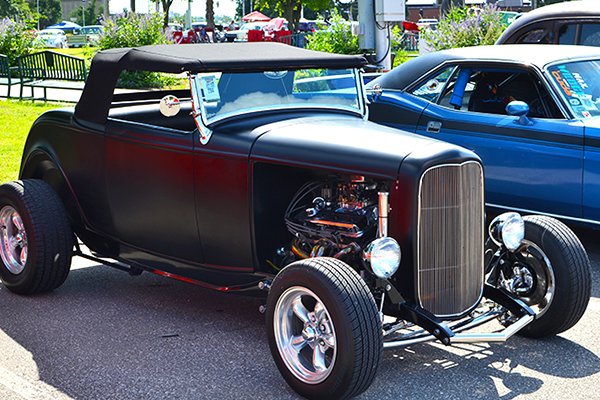One day in May 1978, Tom Boyer headed out to the dry cleaners, expecting to come home with a few pieces of newly cleaned clothes. Instead, he arrived home as the proud owner of a 1937 Cadillac LaSalle, much to the surprise of his wife, Jere.
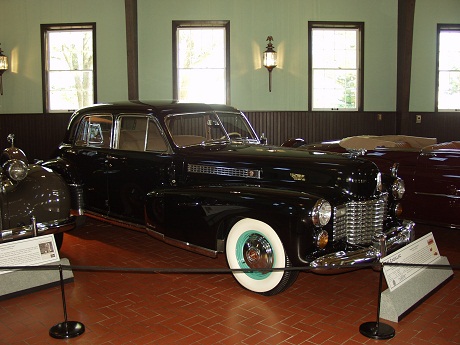 1941 Cadillac. (Photo credit: Gilmore Car Museum.)
1941 Cadillac. (Photo credit: Gilmore Car Museum.)
It had started out innocently enough. All Tom had wanted to do was to pick up his shirts! But, when the dry cleaner’s owner, Wayne, asked him to check out the vintage cars stored in the garage, Tom couldn’t resist.
“Classic cars have always been an interest of mine,” Tom said. “I appreciate their appearance, durability and nostalgic value.”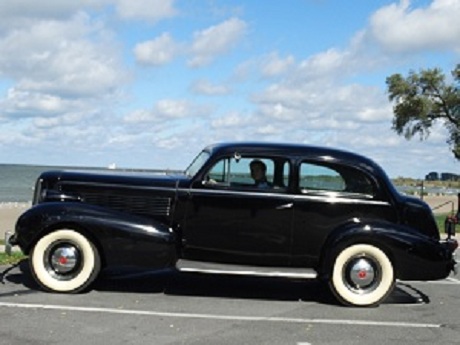 Tom Boyer's grandson Ryan relaxes in the 1937 Cadillac LaSalle. (Photo credit: Tracy Isenberg.)
Tom Boyer's grandson Ryan relaxes in the 1937 Cadillac LaSalle. (Photo credit: Tracy Isenberg.)
The cars included three gorgeous Packards: a 1941 coupe, a 1946 limo and a 1952 sedan. Plus something large and lumpy that was all covered up. When Tom asked Wayne what was beneath that covering, Wayne shared that it was a LaSalle that needed rewiring, and he didn’t know when he’d ever get to the project.
Well, you already know the rest of the story. And, when Tom told Jere about his impending purchase, her reply was, “Honey, I think you’ve just been taken to the cleaners,” but she didn’t try to get him to change his mind.
Since then, the car has been rewired and the fuel pump rebuilt. There is also a new carburetor and new brakes, plus a new battery, springs and tires. The interior has been refurbished and, in 1987, Tom decided that a car as regal as his 1937 LaSalle needed a grander castle, so he built a newer and bigger garage, complete with heat and running water, to house his prized vehicle. He drives it frequently on sunny summer days and lovingly stores it away each winter.
It isn’t surprising that, on some nights, Tom and Jere have popped a bowl of popcorn, poured a couple of soft drinks and watched “All in the Family.” Their favorite part was when Archie sang and Edith warbled in the show intro that “Gee, our old LaSalle ran great . . .”
Birth of the “blood brother to the Cadillac”
The LaSalle was introduced in 1927 after General Motors determined that, for some people, even the lowest-priced Cadillac was out of their financial reach. Yet any of these people could afford more than the highest-priced Buick. In other words, General Motors had uncovered an unfulfilled need and were eager to fill the gap. Moreover, 1927 was the 25th (silver) anniversary of the 1902-founded Cadillac, so the release of a new companion car that year would be perfect timing.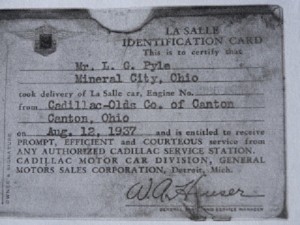 Here is Tom's LaSalle's original identification card. The car was delivered by boat. (Photo credit: Tracy Isenberg.)
Here is Tom's LaSalle's original identification card. The car was delivered by boat. (Photo credit: Tracy Isenberg.)
No longer “any color as long as it’s black”
Okay, so Henry Ford never actually said that. But, the reality is that approximately 12 million of the 15 million Model Ts were black; plus, plenty others were of a darker hue that almost looked black. So, when the LaSalle was being brainstormed, individual styling within a particular vehicle model was almost non-existent.
Although pre-1920s cars are fascinating, they definitely weren’t streamlined in appearance; taken as a whole, they were pretty clunky. In fact, associate professor and chair of the history department at Dowling College, Yanek Mieczkowski, describes cars from the early 1900s as:
- “Tall, boxy and disjointed”
- having “parts that jutted out from its body, as if they had been welded on: headlights, fenders, a luggage rack, running boards, a spare tire, and a bulky radiator grille. The windshield, split into two panels, stood stiff and upright”
- “an arthritic ancestor of today’s sleek, speedy roadsters”
Early manufacturers, Mieczkowski says, “were much more concerned with function than form. Their cars were notoriously unreliable, so engineering refinements had to take precedence over aesthetic appeal.”
Enter Harley Earl
Harley was born in 1893 to a father who owned Earl Carriage Works in Los Angeles, California. At the shop, young Harley helped his father to build and repair horse-drawn carriages and wagons, hands-on training that would serve him well.
At the end of World War I, Don Lee Cadillac bought out Earl Carriage Works and Harley stayed on to help. So, in the 1920s, if you had enough “clams” Harley could customize your Cadillac so that your car took on a distinctive appearance.
Harley catered to the impulses of the affluent Hollywood crowd during the era of flapper starlets, slick gangsters and cigar-chomping movie moguls, in the days when celebrities danced the Charleston and imbibed moonshine in smoke-filled speakeasies. One of his first customers was the popular and wealthy silent film star Roscoe “Fatty” Arbuckle, whose career abruptly ended after he was blamed–probably falsely–for causing the death of an aspiring actress.
Through his job, Harley met the president of General Motors (Alfred P. Sloan, Jr.) and the general manager of Cadillac (Lawrence Fisher); both were so dazzled by Harley’s artistic designs that they hired him to consult on the development of the LaSalle.
The result was a stylish, sporty vehicle that cost anywhere from $2,495 to $2,685, and it came in an astonishing variety of body styles: eleven of them, to be exact. Sales were significant and Harley was hired to head the newly created “art and colour” department for General Motors. Thus, automobile styling was born. Interior of 1937 LaSalle. (Photo credit: Tracy Isenberg.)
Interior of 1937 LaSalle. (Photo credit: Tracy Isenberg.)
It wasn’t just the styling, though, that made the LaSalle unique. According to Walter M.P. McCall, author of 80 Years of Cadillac LaSalle, “The LaSalle was a totally-new car. It was powered by its very own 75-horsepower, 90-degree, L-head, V-type, eight cylinder engine of 303 cubic inch displacement and 3 1/8- inch bore and 4 15/16 inch stroke.”
If you love all of these details, here is a website that provides nuts and bolts info for the LaSalle by year and here is another excellent book: LaSalle: Cadillac’s Companion Car plus a gallery of LaSalle photos.
Yesteryear
If you could go back into time, back to when the LaSalle was debuting, you’d find Herbert Hoover residing in the White House with the economy fairly stable. Yes, America had experienced a mild recession in 1927, but that was only because of the trouble with rising oil prices, plus Henry Ford’s six-month factory shutdown that took place so that he could retire the reliable but old-fashioned Model T and switch production to the brand spanking new Model A automobile.
The average income in the United States in 1927 was $5,496.73 (net was $5,294.21 after a pesky $202.52 was taken out in taxes), putting the LaSalle out of reach for the typical American. As a point of reference, the salary of the average Joe in 1927 would be comparable to an income of $70,047.76 today. 1931 Cadillac. (Photo credit: Gilmore Car Museum.)
1931 Cadillac. (Photo credit: Gilmore Car Museum.)
On the other hand, in an exclusive section of Park Avenue in New York City, the average income was $75,000 in 1927 (which works out to $915,192.22 annually today) and this demographic spent $280 million annually on luxuries, with $10 million of it earmarked for glamorous vehicles. This crowd, though, would be more likely to buy a full-fledged Cadillac or a Packard, rather than the more economically-priced LaSalle.
Approximately 60% of Americans drove some type of car by the latter part of the 20s decade, with nearly 70% of them choosing either a Ford or General Motors vehicle; as a third choice, people were intrigued by the newly created Chrysler company, while starting to turn away from Durant, Willys and Studebaker. Because so many people now had personalized transportation, fewer people rode the railroads and more people moved to the suburbs, since they had an easy way to commute to work in the city.
If you were buying a car in 1927, you’d probably be relieved to discover that state highway departments, in cooperation with the Department of Agriculture, had finally decided to have designated highways with numbers that stayed consistent from coast to coast. That way, officials figured, it would be easier to drive from one state to another without getting lost, a development that still felt new to many people. This endeavor was so successful that, by April 1927, there were 96,626 miles of these state routes (of course, today there are approximately 4 million miles of highway in the country, but who’s counting).
As you drove along one of these scenic highways, you’d see numbered route signs and names of villages, towns and cities welcoming you within their borders – and you might also see quirky signs with sing-songy verses such as this:
The wolf
Is shaved
So neat and trim
Red Riding Hood
Is chasing him
Burma-Shave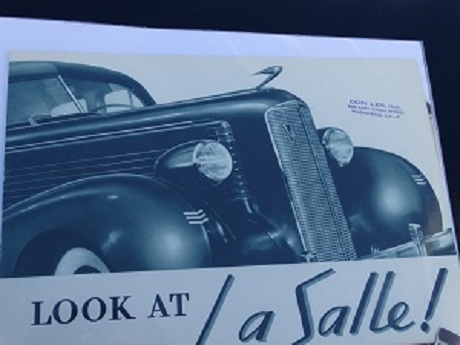 This black, green and cream brochure shares why you should buy a LaSalle; stamped with Don Lee Cadillac. (Photo credit: Tracy Isenberg.)
This black, green and cream brochure shares why you should buy a LaSalle; stamped with Don Lee Cadillac. (Photo credit: Tracy Isenberg.)
These mini-poems served as entertainment for travelers, and also as advertising for a struggling company that was attempting to sell a new product: a revolutionary shaving cream that no longer required brushing on. The product was named Burma-Shave. The owner of the company had a son named Allan Odell, who came up with the idea of these offbeat roadside advertisements and who bought $200 worth of lumber to turn them into reality. As a test, Allan built signs that appeared along the highways in southern Minnesota, since that was close to the family business. Early signs didn’t rhyme, though, and weren’t as catchy as the one quoted above.
As the verses got better, building and posting additional signs became more worthwhile; eventually signs were posted in sets of six, about 100 feet apart, on highways across the country. And, the company that had virtually no sales at the start of 1926 ultimately made $68,000 in sales by that year’s end. During the Depression, when money was extremely tight, sales exceeded $3 million–riches that would be the equivalent of $50 million in 2013.
Optimism largely reigned. After all, because of the invention of talkie movies, people all over the world were watching American-made movies and listening to American voices. Charles Lindbergh flew solo across the Atlantic, while Babe Ruth hit an historic number of home runs. America was at the forefront of the world “dominant in nearly every field, including popular culture, finance and banking, military might, invention and technology.”
So, in 1927, when the LaSalle first hit the highways, it was a great time to be an American and a beautiful day to take a ride!
Subsequent LaSalle models
Three months after the launching of the LaSalle, William “Big Will” Rader, accompanied by renowned dirt track racer Gus Bell, drove a Series 303 LaSalle Roadster chassis for 950 miles during a 10-hour endurance event, travelling at an average of 95.3 miles per hour. The publicity over this accomplishment most likely helped to spur on sales of the LaSalle; 26,807 LaSalles were sold in the first two years of its existence, which were remarkable sales figures for the time.
Sales of the LaSalle remained steady in 1929, but the production of the LaSalle decreased in 1930, thanks to lowered demand after the stock market crash in October 1929, which ushered in the Great Depression. Cadillac’s big news in 1930 wasn’t related to the LaSalle; rather it was focused on their new V-16 engine Cadillac, manufactured to go head-to-head with Packard for the luxury market. Three thousand, two hundred and fifty one Cadillac V-16 cars sold that year, which made Packard executives nervous.
In 1931, Cadillac launched a V-12 engine vehicle and the LaSalle was now nearly a replica of the V-8 engine Cadillac, as far as mechanics went. But the newspaper headlines focused on the economy, which continued to worsen and to threaten the success of any luxury car dealer. The year of 1932 was the worst year for car manufacturers since 1918, which was at the heart of World War I; only 8,084 Cadillacs, including LaSalles, were sold, with the less expensive LaSalle outselling the more expensive Cadillacs. In 1933, the sales figures dropped to 6,655.
In 1934, it was said that Cadillac management planned to drop the LaSalle production altogether, but they were too impressed by Harley Earl’s planned design to follow through. Perhaps the most exciting feature was the new LaSalle engine, which was a 240 cubic-inch straight-8, 95-horsepower engine. This engine was used for three years in the LaSalle (1934-1936). Sales picked up, but Packard’s lower-priced 120 model was providing serious competition for the LaSalle.
Cadillac was happy with the sales of its restyled 1937 LaSalle; overall, Cadillac sold 46,152 cars that year, which was double its 1936 sales and quadruple its 1935 sales. If you search the Internet, you’ll find the following information listed verbatim in multiple places: 1937 - The Cadillac LaSalle V8 set a new speed and endurance record at the Indianapolis 500 with an average speed of 82 miles per hour.
This factoid doesn’t say exactly what speed and endurance record was set, so Advance Auto Parts decided to delve a little deeper. It did take a bit of digging, but what we found was this photo of the original news story from May 10, 1937, along with this caption:
Running under 3-A sanction, as the Indianapolis Speedway prepared for its 25th 500-mile race, a stock LaSalle V8 with case eclipsed the record of the first event. Back in 1911 an especially engineered racing car won the race at an average of 74.59 miles an hour. Ralph DePalma (upper right) who finished sixth in the original "500" in 1911, drove the LaSalle the 500-mile distance. He is shown conferring with Stanley L. Reed, American Automobile Association observer, at the start of the run, which was designed to show the progress of passenger car manufacturing rather than to create new speed records.
For fun, here is the pre-LaSalle vehicle that DePalma drove in 1911.
The year 1938 saw disappointing LaSalle sales, as Packard was taking over more of the lower-end luxury market. By 1940, the decision was made to simply absorb the LaSalle in 1941 into the Cadillac line. From 1941 on, no more LaSalles were produced. Plans for the Cadillac & LaSalle Club Museum & Research Center. (Photo credit: Gilmore Car Museum.)
Plans for the Cadillac & LaSalle Club Museum & Research Center. (Photo credit: Gilmore Car Museum.)
Honoring the LaSalle
Even though the LaSalle only existed for 14 years before being incorporated into the Cadillac line without the “LaSalle” designation, the passion for this gorgeous vehicle still burns strongly. “The appeal for the LaSalle,” says Alan Haas, “is its sportiness. This vehicle exemplifies the art deco design, draw and appeal.”
The early ones, he said, included “open touring cars. LaSalles also came as a convertible coupe with a golf bag door, as full sedans and even as seven-passenger cars.”
Alan’s commitment to preserving the heritage of the LaSalle is significant. After working for Cadillac for 34 years, he “initiated the actions that resulted in the founding of the Cadillac Historical Collection, which is now part of the GM Heritage Center in Sterling Heights, Michigan.” The GM Heritage Center is wholly owned by GM. The Cadillac & Lasalle Club Museum & Research Center is a separate 501(C)(3) organization founded by the Cadillac & Lasalle Club. There is no connection between the two." He served as the president of the Cadillac & LaSalle Club from 1993 to 1998 and is currently serving as the co-chair of the Cadillac & LaSalle Club Museum & Research Center Celebrating the Standard Capital campaign; in this campaign, they are raising $2 million for the construction of a new museum located in the Gilmore Car Museum.
“We just broke ground for the construction,” Alan says, “on Sunday, September 29, 2013. The museum is scheduled to be completed by July 1, 2014 and we’ll have a grand opening celebration at that time. The museum is patterned after General Motors’ dealerships of the 1940s. GM had suggested designs for their dealers and two of them in the 40s–Pemberton in Toledo, Ohio and Brogan Cadillac in New Jersey–built theirs almost exactly to those specifications. We have photos that helped us to use this same design for our museum.”
The LaSalle was, Alan says, “an entry level Caddy in all senses of the word” and the museum will house several LaSalle and non-LaSalle Cadillacs behind a plate glass showroom; there will also be a vehicle prep area and places to display artifacts, signs and other memorabilia. Vehicles displayed will include a 1937 LaSalle convertible sedan, a 1910 Cadillac, the 1957 Eldorado that Dan Ackroyd drove in the film, “Driving Miss Daisy,” an “exquisite” 1930 Cadillac, a 1941 60 special Cadillac and a 1948 60 special, which was the first year that the vehicle included fins; the fins on this particular car are described in more than one place online as “curious tail-fins.”
Alan remembers when General Motors planned to revive the LaSalle name in 1976, to the point that the LaSalle name appeared on the prototype’s dashboard. “Shortly before the car was introduced, though,” he reveals, “the name was changed to ‘Seville.’” The name was considered again for another model, but that never went anywhere.
Whatever happened to the LaSalle designer, Harley Earl?
By the time that Harley had worked just one year for General Motors, he was overseeing a staff of fifty designers, supervising design and color choices for all Fisher Body-built products at General Motors. The longer he worked there, the more influential that he became.
“In the beginning, he shared control of design with the powerful Fisher Brothers,” reads an article found at the GM Heritage Center Site, “but eventually he would gain complete control of automotive styling, both exterior and interior as well as embracing the design of auto exhibits, experimental dream cars, streamlined trains, home appliances, batteries, radios, and all other products and accessories manufactured by General Motors.”
Although Harley struggled to compromise with engineers and although he created designs that failed, he had many more successes; he:
- Blended headlights and fenders into the overall car to create a smooth appearance
- Rid cars of their luggage rack and created the modern trunk
- Concealed the front radiator grille
- Eliminated running boards
- Lengthened and lowered formerly clunky car bodies
- Lowered the passenger compartment for a more comfortable ride
- Used modeling clay to create prototypes of cars so that he could easily make changes before working with metal
- Introduced the four-headlight system, two-tone paint and the one-piece-wrap-around windshield
- Designed the Cadillac Aero-Dynamic Coupe in1933, the first vehicle with a one-piece, all steel roof; previous cars roofs were made from wooden frames and a piece of canvas
- Designed the Buick Y-Job, called the world’s first concept car, intended to test advanced technologies and the public’s reaction to them, rather than for mass production; cutting edge features included fender extensions over the doors, headlamps that disappeared, flush door handles, a convertible top that was covered by metal and electric window regulators.
- Became a vice president at General Motors in 1940
- Incorporated tailfins in Cadillacs in 1948, after being inspired by the P-38 Lightning fighter plane used in World War II; fins continued to grow in both size and popularity on Caddies until 1959 and made appearances through the mid-1960s
- Focused on creating dream cars in the 1950s, which were unique cars that would be sent around the country, to show Americans the future of transportation; innovations during this decade include pillarless hardtops, the first true American sports car (1953 Chevrolet Corvette) and the Firebird gas turbine program
Harley retired in 1959 and moved to Florida. He once said that, “I dream automobiles” and, because of him, a car’s style became an important component of new launches.
What do you think of the LaSalle? Of Harley Earl’s contribution to the world of automobile production? Leave us a comment.



